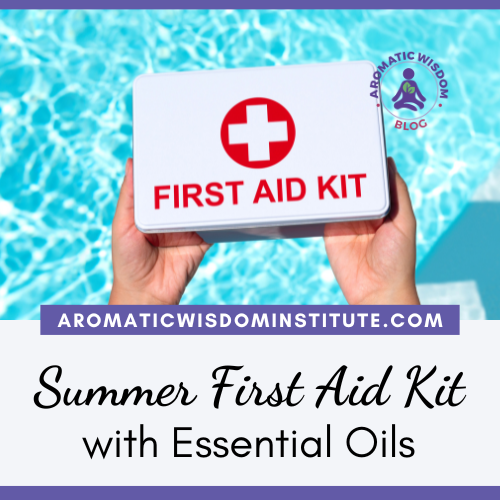🎧Prefer to Listen? Click below
or here: AromaticWisdomPodcast.com/72
I’ve tried to make your summertime first aid essential oil kit as comprehensive as possible for those who want to be prepared for anything from scratches to snake bites. Your summertime first aid kit can contain as many or few as the items below.
Please let me know in the comment section below if I’ve forgotten anything or if you have a favorite item you like to include in your summertime first-aid kit!
1. Essential Oils to include in your first aid kit.
- Tea tree (Melaleuca alternifolia) As an antiseptic to stop stinging and itching of insect stings, topical wounds, poison ivy, and tick bite (apply after the tick is removed, never before). Can be used neat (undiluted) directly on the affected area.
- Lavender (Lavendula angustifolia) For all types of burns (sunburn, hot motorcycle pipes, cooking oil splashes, electrical). Also great for headaches, insomnia, and topical wounds. Can be used neat on the affected area.
- Chamomile, German Matricaria recutita) A natural anti-inflammatory for swelling, and bruising. Mix 4 drops of German Chamomile with 1 tablespoon of carrier oil and rub into the affected area. Lavender and Helichrysum can be added for maximum effect.
- Helichrysum (Helichrysum italicum) For bruises, inflammation, and sprains. I once smashed my finger in the door of a car and applied helichrysum, 2 drops neat, in the first 5 minutes. The reduced swelling and bruising were phenomenal. Mix 4 drops of helichrysum with 1 tablespoon of carrier oil or arnica oil, and reapply frequently to ease pain, swelling, and discoloration of a bruise.
- Peppermint (Mentha piperita) For motion sickness and driving fatigue place a drop on a tissue and stuff in the car air vent. For sinus congestion sniff directly from the bottle or tissue. For a headache, add 1 drop of peppermint essential oil and 1 drop of lavender essential oil to 1 teaspoon of carrier oil and rub on your forehead and back of the neck. be careful to stay away from the eyes.
- Lemongrass (Cymbopogon citratus), Citronella (Cymbopogon nardus), and Catnip Essential Oils (Nepeta cateria) are all very effective mosquito repellents. Add 10 drops of essential oil to 1 ounce of water in a spray bottle. To learn more about repelling mosquitos, click here.
- Thyme (Thymus vulgaris ct linalol) A good tick repellant. Drop thyme oil all around the cuff of your pants and directly on your socks.
- Lemon (Citrus limon): A natural hemostatic that stops bleeding. One or two drops directly on the bleeding wound.
- Clove Bud (Eugenia caryophyllata) For toothache and mouth pain. One drop on a Q-tip and rub around the sore tooth or gum.
- Frankincense (Boswellia carterii) Add to Helichrysum and Lavender for wound care. Include if an asthma attack is a possibility. Add 2-4 drops of Frankincense to 1 tablespoon of carrier oil and rub in the chest.
2. Carriers to include in your first aid kit (for mixing with essential oils)
Include a couple of small bottles of carrier oil to use as a base if you need to mix an oil before applying. For the protection of our skin, essential oils are not used “neat” (undiluted) except under special circumstances. This is to avoid essential oil sensitization. I wrote a hugely popular blog post called Essential Oil Blending Guidelines and Dilutions that will help you make safe and effective first aid blends. Always put your carriers in clean, empty 1-ounce or 2-ounce PET flip-top plastic bottles.
Vegetable Oils: I recommend cold-pressed, hexane-free Organic Jojoba Oil or Organic Fractionated Coconut Oil. Both of these carriers are very stable which means they have a long shelf-life and won’t become rancid if stored in your first aid kit all summer. Don’t use nut oils as they will oxidize and go rancid quickly, especially in hot weather.
Aloe Vera Gel: Be careful here. There is a lot of garbage out there calling itself Aloe Vera Gel. I deep dive into this subject in this blog post. You want to buy Aloe Vera Gel that is organic, bottles without preservatives and freshly made. I love this one by Seven Minerals. I recommend Aloe Vera gel in your first aid kit because of its cooling, soothing effect and in particular for the treatment of topical burns. (Heck, you could even swish it in your mouth if you burn your tongue on a hot marshmallow hiding in your s’more). For the inevitable summer sunburn, there’s nothing better for instant (and long-term) relief than Lavender essential oil mixed with Aloe Vera gel. Because my family is outside a lot when the weather is warm, I make sure I always have a couple of pre-made 4-ounce bottles of this Aloe/Lavender blend in my fridge. I make it at a 2% dilution, but you could even go up to 3% dilution if the burn is bad. Aloe doesn’t have a long shelf-life and is fragile in the heat so keep all Aloe products in the fridge or ice chest if you’re on the move. Heck, once I even used my Aloe/Lavender blend as a deodorant in a pinch. My armpits were cool, fresh with a hint of flowers. 🙂
Arnica Salve (Arnica montana). The arnica plant is ah-mazing! It has a ton of therapeutic properties that you really want when the unexpected happens. Especially if you’re, say, camping and far from a doctor. Arnica salve helps with muscle pain and promotes the healing of bruises, especially when blended with Helichrysum essential oil. It further helps
Calamine lotion: Include a small bottle to use as a carrier for peppermint and tea tree for poison ivy relief. Add about 10 drops each of Peppermint and Tea Tree to 1 ounce of Calamine lotion and rub on the poison ivy. Personally, I love my own recipe for a superb DIY Calamine lotion with natural ingredients which is incredibly easy to make and really stops the itch and helps draw out infection.
3. Other items to include for a complete first aid kit.
Gauze
Medical Tape
Moleskin patches for blisters (also great for blister prevention)
Bandaids in assorted sizes; include antibacterial and waterproof
Small scissors
Tick removal tool
small ziplock bags for keeping any ticks you remove. They can be taken for Lymes disease testing.
Mercury-free old-fashioned thermometer and case. No batteries are required.
Children’s and Adult electrolyte powder
Bottle of water. If your first aid kit is going to sit for long period of time, I would fill a BPA-free water bottle or stainless.
Vemon extraction kit for insects, spiders and snakes.
If there is any risk of an allergic reaction to plants, bites or stings, you can’t do better than the PracMedic Bag holds 2 Epi-Pens and an Asthma Inhaler and comes in an easy-to-spot red pouch.
Reference Sheet: Include a list of what each essential oil does and why it is in the first aid kit. This is a good reminder or even an important list for someone who needs to use the kit but has no experience with essential oils.
A truly complete first-aid kit contains some conventional products to complement the function of the essential oils and carriers; such as acetaminophen or ibuprofen, water-free hand sanitizer, and all prescription medications in addition to the items listed above.
Have I forgotten anything?
What else would YOU include in your first aid kit? Leave comment below and let me know!
This blog post was updated on May 17, 2024 and may contain affiliate links which means I may receive a small commission if you make a purchase using them. The commission is paid by the retailer at no extra cost to you.





I like to use baking soda mixed with enough water to make a paste. Put the paste over the bee or wasp sting to draw out the posion. Once the paste is dry extraction is complete. The area may itch but the majority or all of the pain should be gone.
Excellent idea Ally! You could even add a drop of Tea Tree essential oil to that paste! So a small container or bag of baking soda could be added to the first aid kit. It would need to be well-sealed to avoid mositure creeping in and making it like a brick. Thanks for the wonderful suggestion!
I really enjoyed your article. That is nice when you read something that is not only informative but entertaining. That True! A well-stocked first aid kit is a handy thing to have. We should always prepared for emergencies, need to keep a first aid kit in our home and in our car.
Really So helpful Summer First-Aid Kit..
Wonderful article, thank you for sharing that. I will be making my first aid kit soon. I have two little ones under 4. Are these oils and dilution safe for them to use? at least for emergencies? Thank you.